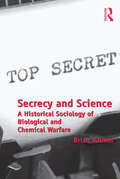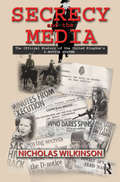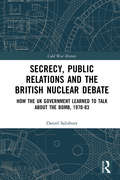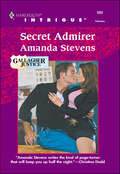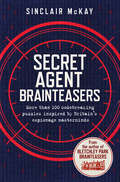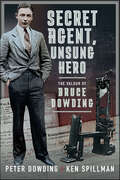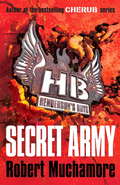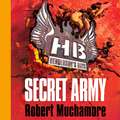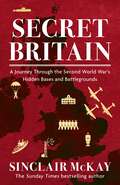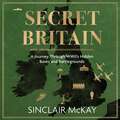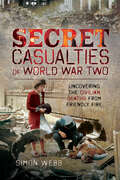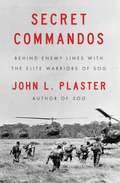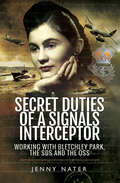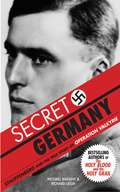- Table View
- List View
Second to None: The History of the Coldstream Guards, 1650–2000
by Julian PagetFamiliar to tourists at Buckingham Palace, the Coldstream Guards are also a fully operational combat unit. The regiment played a key role at Blenheim and Waterloo, fought at Monmouth in the American Revolution, served in both World Wars and is frequently deployed on short notice to the world's trouble spots even today. This lavishly illustrated volume has been produced to mark the regiment's 350th anniversary. Contributors include numerous distinguished British historians and past members of the regiment. Full details are given for both the Coldstream Guards' ceremonial duties and their participation in some of the key events in European history.
Seconds to Sunrise
by Nico RossoReaders of Maya Banks's KGI series will love the adrenaline-fueled, pulse-pounding suspense of Nico Rosso's SECONDS TO SUNRISE She thought she'd lost everything... April Banks thought her website crashing was just a glitch. Starting the online forum for war widows has been the only thing keeping her together since her husband died, and she won't let anything interfere with her work. But this is no technical malfunction-cyberterrorists have targeted the information locked in April's website and they'll do anything to get it. Even if that means removing April. Permanently. He'll make them pay... Automatik gave former SAS agent James Sant a way to protect the innocent again. He thinks life in the shadows is all he deserves...until he meets his newest assignment. April is everything James has never let himself want and he knows she's already had too much heartbreak in her life to risk feeling for him. But keeping things professional while hunting the hackers with the gorgeous widow is going to be the hardest job he's ever taken on. This book is approximately 75,000 words One-click with confidence. This title is part of the Carina Press Romance Promise: all the romance you're looking for with an HEA/HFN. It's a promise! Find out more at CarinaPress.com/RomancePromise
Secrecy and Science: A Historical Sociology of Biological and Chemical Warfare
by Brian BalmerIt is no secret that twentieth-century Britain was governed through a culture of secrecy, and secrecy was particularly endemic in military research and defence policy surrounding biological and chemical warfare. More generally, it is hard to exaggerate the role of secrecy in all past biological and chemical warfare programmes and several recent historical surveys of biological and chemical warfare research have emphasised that all state sponsored programmes, together with sub-state organised activities, were cloaked in utmost secrecy. Of these research programmes, Britain carried out one of the most significant in scale and scope in the twentieth century. Yet, partly because of the secrecy surrounding the programme, there is still little academic literature on its historical development. Equally, and despite secrecy being a pervasive feature of past and contemporary societies, social scientists and historians have paid relatively little scholarly attention to the nature, mechanics and effects of secrecy, particularly with regard to secrecy in relation to the production and governance of science and technology. Drawing on classical sociological writing on secrecy by Simmel, Merton and Shils this groundbreaking book by Brian Balmer draws on recently declassified documents to investigate significant episodes in the history of biological and chemical warfare. At the same time, it draws on more contemporary perspectives in science and technology studies that understand knowledge and social order as co-produced within heterogeneous networks of 'things and people' in order to develop a theoretical set of arguments about how the relationship between secrecy and science might be understood.
Secrecy and the Media: The Official History of the United Kingdom's D-Notice System (Government Official History Series)
by Nicholas John WilkinsonSecrecy and the Media is the first book to examine the development of the D-Notice system, which regulates the UK media's publication of British national security secrets. It is based on official documents, many of which have not previously been available to a general audience, as well as on media sources. From Victorian times, British governments have consistently seen the need, in the public interest, to prevent the media publishing secret information which would endanger national security. The UK media have meanwhile continuously resisted official attempts to impose any form of censorship, arguing that a free press is in the public interest. Both sides have normally seen the pitfalls of attempting to resolve this sometimes acrimonious conflict of interests by litigation, and have together evolved a system of editorial self-regulation, assisted by day-to-day independent expert advice, known colloquially as the D-Notice System. The book traces the development of this system from nineteenth-century colonial campaigns, through two world wars, to modern operations and counter-terrorism in the post-Cold War era, up to the beginning of the Labour government in 1997. Examples are drawn from media, political and official sources (some not yet open), and cover not only defence issues (including Special Forces), but also the activities of the secret intelligence services MI5, MI6 and GCHQ. These cases relate principally to the UK, but also to American and other allies' interests. The story of how this sometimes controversial institution now operates in the modern world will be essential reading for those in the media and government departments, and for academics and students in the fields of security, defence and intelligence, as well as being an accessible exposé for the general reader. Nicholas Wilkinson served in the Royal Navy 1959-98, and from 1999 to 2004 he ran the independent Defence, Press and Broadcasting Advisory Committee. He was a Press Complaints Commissioner from 2005 to 2008, and is a Cabinet Office Historian.
Secrecy, Public Relations and the British Nuclear Debate: How the UK Government Learned to Talk about the Bomb, 1970-83 (Cold War History)
by Daniel SalisburyThis book constitutes an original archival history of government secrecy, public relations and the debate surrounding nuclear weapons in Britain from 1970 to 1983. The book contrasts the secrecy and near-silence of the Heath, Wilson and Callaghan governments on nuclear issues in the 1970s with the increasingly vocal case made for the possession of nuclear weapons by the first Thatcher government following a shift in approach in 1980. This shift occurred against a background of rising Cold War tensions and a growing public nuclear debate in the UK. The book seeks to contextualise and explain this transformation, considering the role of party politics, structures and personalities inside the government, and external influences: notably the role of investigative journalists and think tanks in cracking open official secrecy and demanding justification for Britain’s possession of nuclear weapons, and the peace movement in driving increasingly assertive public relations from 1980. The book draws on material from archives and interviews with key figures involved to provide an original and engaging account. It argues that this process of opening up saw significant disclosure of nuclear policy for the first time, and the most extensive public justification of the British nuclear capability to date, which has shaped public understanding of British nuclear weapons into the twenty-first century. This book will be of much interest to students of British politics, Cold War studies, nuclear politics and security studies.
Secret Admirer (Gallagher Justice)
by Amanda StevensGet ready for a new brand of justice... Born to a legacy of lawman, three brothers sworn to serve and protect will safeguard the women they love.GALLAGHER JUSTICEWith a wickedly sexy smile and reputation to match, detective Tony Gallagher was the Chicago P.D.'s bad boy. Tony had one rule: he always worked alone. Until a murder case pushed him to the edge-and he got a new partner...Working with Tony was Eve Barrett's dream come true-and her worst nightmare. As a girl she'd loved him, but he'd never noticed her. Now she had to find her growing desire, and her real assignment: investigating Tony.With women he knew dying, Tony trusted no one. Eve had to win his confidence-before a clever killer discovered the secrets of his heart...
Secret Agent Brainteasers: More Than 100 Codebreaking Puzzles Inspired by Britain's Espionage Masterminds
by Sinclair McKayHave you daydreamed of being approached to be a secret agent? Imagined yourself being propelled into the dangerous and elegant world of spies?Blending extraordinary and illuminating historical tales of the British Secret Intelligence Service from over the years with a wide range of mind-twisting puzzles, Secret Agent Brainteasers will test your mental agility to discover: Do YOU have what it takes to be a spy?Long gone are the days when the tap on the shoulder was largely a result of social connections. Now the secret intelligence services have cast their nets wider, and it's your chance to join the ranks. Whether you have a linguistic flair, an instinct for technology, or good old common sense, pit your wits against some of the greatest minds of our time with ingenious brainteasers including secret languages, sabotage-themed brain bogglers, and hidden codes.
Secret Agent Santa
by Carol EricsonChristmas was supposed to be about joy and hope...not about thwarting terrorist plots Most covert agents weren't blessed with long careers. Mike Becker wasn't like most agents. On the cusp of early retirement, he's given one final assignment: babysit a single mother with a reputation for coming up with conspiracy theories. Except the bullets flying Claire Chadwick's way can't be dismissed. Now Mike will do anything to protect her and her son, and uncover the truth. A truth that places them at the center of a terrorist attack on Christmas Day. Mike's career may be coming to a blazing finish, but in this woman he finally has a shot at the redemption that's eluded him for so long.
Secret Agent, Unsung Hero: The Valour of Bruce Dowding
by Ken Spillman Peter DowdingYoung Australian teacher Bruce Dowding arrived in Paris in 1938, planning only to improve his understanding of French language and culture. Secret Agent, Unsung Hero draws on decades of research to reveal, for the first time, his coming of age as a leader in escape and evasion during World War II. Dowding helped exfiltrate hundreds of Allied servicemen from occupied France and paid the ultimate price. He was beheaded by the Nazis just after his 29th birthday in 1943.
Secret Anniversaries
by Scott SpencerDuring WWII, a naive young woman is hired by a Nazi-sympathizing congressman, in this novel by the New York Times–bestselling author of A Ship Made of Paper. As the Second World War heats up, Caitlin Van Fleet moves to Washington, DC, to become a &“government girl&” in the office of Congressman Stowe, who has connections to such controversial figures as the fiery radio commentator Father Coughlin and the German-American Bund. Young and impressionable, Caitlin enters into a passionate love affair with the congressman&’s aide, Betty Sinclair. But their relationship, while intense, is short-lived. When Caitlin befriends Joe Rose, an undercover reporter working to expose Stowe as a Nazi collaborator, she must decide once and for all what she truly stands for. From a two-time National Book Award finalist known for such novels as Endless Love, The Rich Man&’s Table, and An Ocean Without a Shore, New York Times Notable Book Secret Anniversaries brings to life the political controversies surrounding World War II, and delves into one woman&’s decades-long journey as she wrestles with questions of passion and principle. &“Spencer is one of my very favorite writers.&” —Emma Cline, New York Times–bestselling author of The Girls &“A gifted storyteller.&” —Newsday &“A magnificent writer.&” —Anne Tyler, Pulitzer Prize–winning author of Redhead by the Side of the Road
Secret Army: Book 3 (Henderson's Boys #3)
by Robert MuchamoreBritain, 1941.The government is building a secret army of intelligence agents to work undercover, gathering information and planning sabotage operations. Henderson's boys are part of that network: kids cut adrift by the war, training for the fight of their lives. They'll have to parachute into unknown territory, travel cross-country and outsmart a bunch of adults in a daredevil exercise.In wartime Britain, anything goes.
Secret Army: Book 3 (Henderson's Boys #3)
by Robert MuchamoreBritain, 1941.The government is building a secret army of intelligence agents to work undercover, gathering information and planning sabotage operations. Henderson's boys are part of that network: kids cut adrift by the war, training for the fight of their lives. They'll have to parachute into unknown territory, travel cross-country and outsmart a bunch of adults in a daredevil exercise.In wartime Britain, anything goes.(P) Hodder Children's Books 2015
Secret Britain: A journey through the Second World War's hidden bases and battlegrounds
by Sinclair McKayDiscover the stories of the brave men and women who worked, trained and fought across the UK, from Bletchley Park in southern England all the way to Arisaig in northern Scotland, in an unbelievable effort to defeat the Nazis and win the Second World War .From the outset of the war, most of Britain felt like a mystery even to those who lived there. All road and railway signs were removed up and down the country to thwart potential enemy spies. An invisible web of cunning spread across the United Kingdom; secret laboratories were hidden in marshes, underground bases were built to conceal key strategic plans and grand country houses became secret and silent locations for eccentric boffins to do their confidential cryptography work.In Secret Britain, Sinclair McKay maps out the UK through the hidden bases and battlegrounds of WWII. These locations are full of history and intrigue, but if you don't know where to look, you might just miss them. Journeying through secret wildernesses, suburbs, underground tunnels and manor houses, Sinclair gives a glimpse into the stories of the incredible people behind the war effort, and shows how you might be able to visit these mysterious and evocative locations yourself.With his trademark warmth and compassion, Sinclair unearths the truths of the war that have remained under layers of secrecy since the war was won in 1945.
Secret Britain: A journey through the Second World War's hidden bases and battlegrounds
by Sinclair McKayDiscover the stories of the brave men and women who worked, trained and fought across the UK, from Bletchley Park in southern England all the way to Arisaig in northern Scotland, in an unbelievable effort to defeat the Nazis and win the Second World War .From the outset of the war, most of Britain felt like a mystery even to those who lived there. All road and railway signs were removed up and down the country to thwart potential enemy spies. An invisible web of cunning spread across the United Kingdom; secret laboratories were hidden in marshes, underground bases were built to conceal key strategic plans and grand country houses became secret and silent locations for eccentric boffins to do their confidential cryptography work.In Secret Britain, Sinclair McKay maps out the UK through the hidden bases and battlegrounds of WWII. These locations are full of history and intrigue, but if you don't know where to look, you might just miss them. Journeying through secret wildernesses, suburbs, underground tunnels and manor houses, Sinclair gives a glimpse into the stories of the incredible people behind the war effort, and shows how you might be able to visit these mysterious and evocative locations yourself.With his trademark warmth and compassion, Sinclair unearths the truths of the war that have remained under layers of secrecy since the war was won in 1945.(P) 2021 Headline Publishing Group Ltd
Secret Casualties of World War Two: Uncovering the Civilian Deaths from Friendly Fire
by Simon WebbThis study of friendly fire on civilians during the London Blitz and the attack on Pearl harbor exposes the unknown horror behind these iconic WWII events.The London Blitz and the Japanese attack on Pearl Harbor have ascended to the level of myth for Britain and America. Yet both of these artfully constructed narratives of heroic resistance to aerial bombardment conceal the massacre of citizens by the very militaries charged with protecting them. In Britain, thousands of civilians were killed when the army shelled London and other cities to prevent residents from fleeing the German bombs. At Pearl Harbor, American warships fired their heavy guns at the city of Honolulu with devastating results.Simon Webb begins this volume with an overview of bombing and anti-aircraft guns from the Franco-Prussian War of 1870-1871 through to the First World War. He then reveals the casualties which friendly fire from heavy artillery inflicted upon British and American civilians during World War Two. In the case of the British, these deaths were a deliberate part of a shockingly cynical policy. There were times during the German bombing of London when more people were being killed by British shells than by enemy bombs.
Secret Channel to Berlin: The Masson-Schellenberg Connection and Swiss Intelligence in World War II
by Pierre Th. BraunschweigA revealing account of Swiss intelligence operations during WWII, including a secret backchannel between Switzerland and Nazi Germany. During World War II, Col. Roger Masson, the head of Swiss Intelligence, maintained a secret link to the German Chief of Espionage, SS Gen. Walter Schellenberg. With access to previously inaccessible documents, including newly discovered material in American archives, historian Pierre Braunschweig fully illuminates this connection for the first time, along with surprising new details about the military threats Switzerland faced in March 1943. During World War II, Switzerland was famous as a center of espionage fielded by Allies and Axis alike. Less has been known, however, about Switzerland&’s own intelligence activities, including its secret sources in Hitler&’s councils and its counterespionage program at home. In Secret Channel to Berlin, Braunschweig details the functions of Swiss Intelligence during World War II and sheds new light on conflicts between Swiss Intelligence and the federal government in Bern, as well as within the intelligence service itself.
Secret Commandos: Behind Enemy Lines with the Elite Warriors of SOG
by John L. PlasterMajor John L. Plaster recalls his remarkable covert activities as a member of a special operations team during the Vietnam War in a “comprehensive, informative, and often exciting…account of an important part of the overall Vietnam tragedy” (The New York Times).Before there were Navy SEALs, there was SOG. Short for “Studies and Operations Group,” it was a secret operations force in Vietnam, the most highly decorated unit in the war. Although their chief mission was disrupting the main North Vietnamese supply route into South Vietnam, SOG commandos also rescued downed helicopter pilots and fellow soldiers, and infiltrated deep into Laos and Cambodia to identify bombing targets, conduct ambushes, mine roads, and capture North Vietnamese soldiers for intelligence purposes. Always outnumbered, they matched wits in the most dangerous environments with an unrelenting foe that hunted them with trackers and dogs. Ten entire teams disappeared and another fourteen were annihilated. This is the dramatic, page-turning true story of that team’s dedication, sacrifice, and constant fight for survival. In the “gripping” (Publishers Weekly) Secret Commandos, John Plaster vividly describes these unique warriors who gave everything fighting for their country—and for each other.
Secret Defender
by Debbi RawlinsAN HEIRESS TO PROTECTLuke Boudreau was a man unlike any other and he would stop at nothing to keep Sydney Wainwright safe-even if it meant kidnapping the headstrong heiress. Only, the tough-as-nails investigator never anticipated that a daring double cross would send him and Sydney on the run.Now, uncovering the threat to Sydney’s life lay in the clues to a perilous puzzle that only brought the two closer together. Though Luke knew he should keep his professional distance, his feelings for the young beauty became increasingly personal. And now, evading the determined killer on their trail seemed easier than resisting Sydney....
Secret Duties of a Signals Interceptor: Working with Bletchley Park, the SDS and the OSS
by Jenny NaterThis WWII memoir recounts a woman’s experience translating top-secret German communications for British intelligence.Like many British women on the homefront of World War II, Jenny Nater discovered an unexpected way to put her talents to use. She served as a bilingual wireless operator in the top-secret Special Duties service at Dover, intercepting traffic from German surface craft in the English Channel and reporting it back to Bletchley Park. In this memoir, Nater discusses this important work, as well as the life-changing relationships she made in that time—most notably with a Coastal Force Command Lieutenant who would be tragically lost. She also describes working in Germany for America’s Office of Strategic Services (OSS). It was during this time that she met her husband, a Mosquito pilot and member of the Caterpillar Club whose spy missions over occupied Europe are also described here in full.This memoir add an important layer to our understanding of allied intelligence practices during this conflict. They also tell the story of one woman’s very private war, and the opportunities, sacrifices, and victories it encompassed.
Secret Flotillas: Clandestine Sea Operations to Brittany, 1940–44
by Brook RichardsAs the fall of France took place, almost the entire coastline of Western Europe was in German hands. Clandestine sea transport operations provided lines of vital intelligence for wartime Britain. These "secret flotillas" landed and picked up agents in and from France, and ferried Allied evaders and escapees. This activity was crucial to the SIS (Secret Intelligence Service) and the SOE (Special Operations Executive). This authoritative publication by the official historian, the late Sir Brooks Richards, vividly describes and analyses the clandestine naval operations that took place during WWII. The account has been made possible through Sir Brooks' access to closed government archives, combined with his own wartime experiences and the recollections of many of those involved.First published in 1996, the original edition included descriptions of naval operations off French North Africa. The history has now been amended and expanded by Sir Brooks and is now published in two volumes. This first volume concentrates on the sea lines to Brittany.This authoritative publication by the official historian, the late Sir Brooks Richards, vividly describes and analyses the clandestine naval operations that took place during World War Two.
Secret Flotillas: Vol. I: Clandestine Sea Operations to Brittany, 1940-1944 (Government Official History Series)
by Brooks RichardsWith the fall of France, almost the entire coastline of Western Europe was in German hands. Clandestine sea transport operations provided lines of vital intelligence for wartime Britain. These 'secret flotillas' landed and picked up agents in and from France, and ferried Allied evaders and escapees. This activity was crucial to the SIS (Secret Intelligence Service) and the SOE (Special Operations Executive). This authoritative publication by the official historian, the late Sir Brooks Richards, vividly describes and analyses the clandestine naval operations that took place during World War Two.
Secret Flotillas: Vol. II: Clandestine Sea Operations in the Western Mediterranean, North Africa and the Adriatic, 1940-1944 (Government Official History Ser.)
by Brooks RichardsThis authoritative publication by the official historian, the late Sir Brooks Richards, vividly describes and analyses the clandestine naval operations that took place during World War II.
Secret Forces of World War II
by Philip WarnerOne of the lasting legacies of World War 2 was the proliferation of what today are known as Special Forces. At the time many soldiers, often of high rank regarded these units as nothing short of ill-disciplined cowboys or worse! However desperate times called for desperate measures and there were those in high places who were prepared to take risks. As specially recruited units such as the LRDG, SAS and SBS earned their spurs and scored significant victories, at high cost both to the enemy and themselves, so faith in the concept grew
Secret Germany: Stauffenberg and the True Story of Operation Valkyrie
by Michael Baigent Richard LeighBy July of 1944, the Third Reich's days were numbered. Colonel Claus von Stauffenberg, a general staff insider with open eyes (and access to the Führer), was convinced that assassinating Hitler was the only way to prevent the destruction of the Fatherland and the deaths of millions. On July 20, he hid a bomb-stuffed briefcase at a high-level meeting. The explosion tore through the room, but a table leg spared Hitler from the blast. The result was a witch hunt, a wave of executions, and a further pointless year of war. Michael Baigent and Richard Leigh deliver an exhilarating and definitive portrait of the anti-Nazi movement (called "Secret Germany") that almost killed Hitler. Secret Germany is the story of "World War II's boldest plot-that-failed" (Time), a coup that was a moral and spiritual necessity.
Secret History of Chemical Warfare
by N. J. McCamleyThis book offers a full examination and description of all the toxic chemical and microbiological agents, either tested, manufactured or used since 1914. It identifies the major research, testing and manufacturing plants worldwide with special emphasis on the UK and North America. Among the British sites are Porton Down (Wiltshire), Sutton Oak (Lancashire), Nancekuke (North Cornwall) and the ICI-operated plants at Rhydymwn (North Wales) and St Helens and elsewhere in Lancashire.It details all verifiable uses of CBW since 1914 and examines the rationale behind such operations. Also studied is the arms race for CBW between competing powers. The author uncovers the scientific arrogance and political ignorance that has led to a greatly exaggerated perception of the potency of CBW, which he maintains is still the case today.Finally McCamley reveals the scandalous history of inadequate and dangerous storage and disposal practices.


